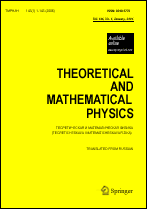|
Axions and cosmic rays
D. Espriuab, A. Renaub
a CERN, Geneva, Switzerland
b Department of Structure and Constituents of
Matter, Institute of Cosmos Sciences, University of Barcelona, Barcelona, Spain
Abstract:
We investigate the propagation of a charged particle in a spatially constant but time-dependent pseudoscalar background. Physically, this pseudoscalar background could be provided by a relic axion density. The background leads to an explicit breaking of Lorentz invariance; processes such as $p \longrightarrow p\gamma$ or $e\longrightarrow e\gamma$ are consequently possible under some kinematic constraints. The phenomenon is described by the QED Lagrangian extended with a Chern–Simons term that contains a four-vector characterizing the breaking of Lorentz invariance induced by the time-dependent background. While the induced radiation (similar to the Cherenkov effect) is too small to influence the propagation of cosmic rays significantly, the hypothetical detection of the photons radiated by high-energy cosmic rays via this mechanism would provide an indirect way to verify the cosmological relevance of axions. We discuss the order of magnitude of the effect.
Keywords:
axion, high-energy cosmic ray, galactic magnetic field.
Received: 13.02.2012
Citation:
D. Espriu, A. Renau, “Axions and cosmic rays”, TMF, 170:2 (2012), 304–320; Theoret. and Math. Phys., 170:2 (2012), 249–262
Linking options:
https://www.mathnet.ru/eng/tmf6768https://doi.org/10.4213/tmf6768 https://www.mathnet.ru/eng/tmf/v170/i2/p304
|


| Statistics & downloads: |
| Abstract page: | 410 | | Full-text PDF : | 225 | | References: | 39 | | First page: | 4 |
|




 Contact us:
Contact us: Terms of Use
Terms of Use
 Registration to the website
Registration to the website Logotypes
Logotypes








 Citation in format
Citation in format 